Here's how to butcher a lamb…
Two weeks ago, we said goodbye to our beloved ram lamb Guido, and hello to the most delicious meat I've ever tasted.
Okay – next to our homegrown chicken and pork, of course. But this lamb stands alone. WOW.
If you're on the fence, come to my farm. I'll roast you a rump roast that's been marinating in garlic and spices until it's cooked a perfect medium rare.
You'll take a bite…
… and then you'll beg me to let you come and live on the farm so you can eat this incredible lamb all year round.
… and I'll let you, of course, because I'm nice like that. But I'll make you promise to always do the dishes.
… and then together, we'll eat lots of delicious meals centered around succulent red meat that is far too often disregarded in our culture.
I think it's only fair to meat everywhere that even if you “don't like lamb” you give real, grass-fed lamb a try. Sourced from a local farm would be best. Because our Katahdin lamb was enough to even have my parents moaning in culinary bliss (they'd never had lamb before).
You're going to hear me talking a lot about lamb soon because we've decided to go into the meat sheep business. Over the next few years, we're going to work on expanding our Katahdin herd and preparing lamb for sale in the real marketplace.
It's just amazing. Seriously. I don't know how else to say it.
Couple that tender, fatty meat with the fact that these animals fatten quickly… and on grass!… and it's a recipe for perfection.
But before the recipes come the hard part. The butchering. So here's how to butcher a lamb.
How To Butcher A Lamb
1. Separate the lamb.
Withhold feed for 12-24 hours. This will ensure the rumen is empty come evisceration time (an empty gut is much easier to work with than a full one).
2. Kill the lamb.
Some prefer to slit the lambs throat. Others, like us, choose to shoot the lamb. The only essential is that the animal is calm and that the kill is instantaneous. It's very important to me that the animal remains happy until it's last moment and that the moment happens without any stress or struggle. Guido was shot with a .38 revolver in the back of the skull. He died instantly.
After he was shot, his throat was slit to help release the blood. I jumped into the pen and held his head and shoulders on my lap, using my hands to massage the blood out of his body, and gave thanks for him.
3. Hang the lamb.
There's a really strong tendon that runs on the back side of the leg. A quick poke with a knife through the back of the leg allows you to easily hang the lamb up by that tendon.
Oh wait… you mean that tendon? The tendon I just slit there with my super sharp knife? Fuh-get-about-it…
We used a gambrel and some basic wire to hang ours. Very primitive. No need for super-specialized equipment.
4. Skin the lamb.
There are a million methods to skinning a lamb, but the basics are very simple. We cut around the top of the leg and used a sharp knife to gently separate the skin from the flesh. After beginning, it was easy enough to push with our fingers and separate that way. The hide was cut inwards, along the butt of the lamb, towards the anus – which was tied off with a string to ensure that nothing left the backside and contaminated the meat – and then down the belly. After you cut around the anus, it's easy enough to pull the hide off (sort of like pulling a sweater off) until you get to the head.
By the way, the hide is currently curing in salt in our shop awaiting it's tanning destiny.
5. Remove the head.
Gently cut through the flesh at the top of the neck until you hit the spine. Located a vertebrae and cut between it and the next one. Use your hands to twist the lamb's head until it pops off, using your knife to separate any spare bits of flesh.
You should now have a skinned, headless carcass. You can remove the front hooves at this point, if you wish, by locating the first joint, bending the hoof with your hand, and using your knife to separate it at the joint.
6. Eviscerate the animal.
The process is very similar for every animal. DON'T PUNCTURE GUT-TOWN, man. Be careful! A small slit at the top will get it started – continue cutting down the belly of the carcass with just the tip of your knife – very shallow cuts.
Using your hands, work the innards free. I prefer my hands because I'm much less likely to puncture the guts with my fingers than with a knife. All that's in the body cavity needs to come out, by any means necessary.
We kept the liver, kidneys, and heart. The lungs and head went to Toby. The intestines were composted. Not an ounce wasted.
7. Rinse the lamb.
Your lamb should be hide-less, head-less, hoof-less, and gut-less. It should resemble a carcass hanging in a butcher shop. Once final rinse of water will ensure any stray hairs or dirt have been removed.
8. Age the lamb.
Our lamb was then placed in a canvas bag and hung in an outside tree for 1 week to age. The temperature was perfect for this: between 36 and 43 degrees. If you butcher at a warm time of year, you'll want to refrigerate the carcass. This helps the flavors to develop, the muscles to relax, and some of the moisture to dissipate.
9. Butcher the carcass into cuts.
After one week, we brought the carcass inside and spent a few hours butchering it ourselves. We watched this fantastic video that walked us through a step-by-step process on how to cut up the carcass and since doing the Farmstead Meatsmith's class last fall with our pigs, we felt a lot more confident in recognizing bones, cuts, etc.
Although, take note, you'll want a pretty hefty bone saw to do this part. We had a weeny one and it was a lot of work – a lot more than it would have been if we just had the right bone saw to begin with.
Sharp knife. Hefty bone saw. Easy peasy.
Each cut was wrapped in plastic wrap and then in butcher paper before it was labeled and put into the deep freeze.
If you've never raised your own meat, there's simply no way to describe the incredible joy that comes from stepping back and staring at the final product. Guido was a beautiful ram – a ram fed by our own hands each day. We cared for him.
… and that care, that dedication, that commitment to him, makes the pleasure of his sacrifice and life-sustaining meat all the more appreciated.
Every bite is savored. And not an ounce is wasted.
And Amen.
More posts on Sheep:
- The Sheep Saga
- Why You Need Sheep
- Preparing for Sheep on the Farm
- Preparing for Lambing
- Lambing in Winter

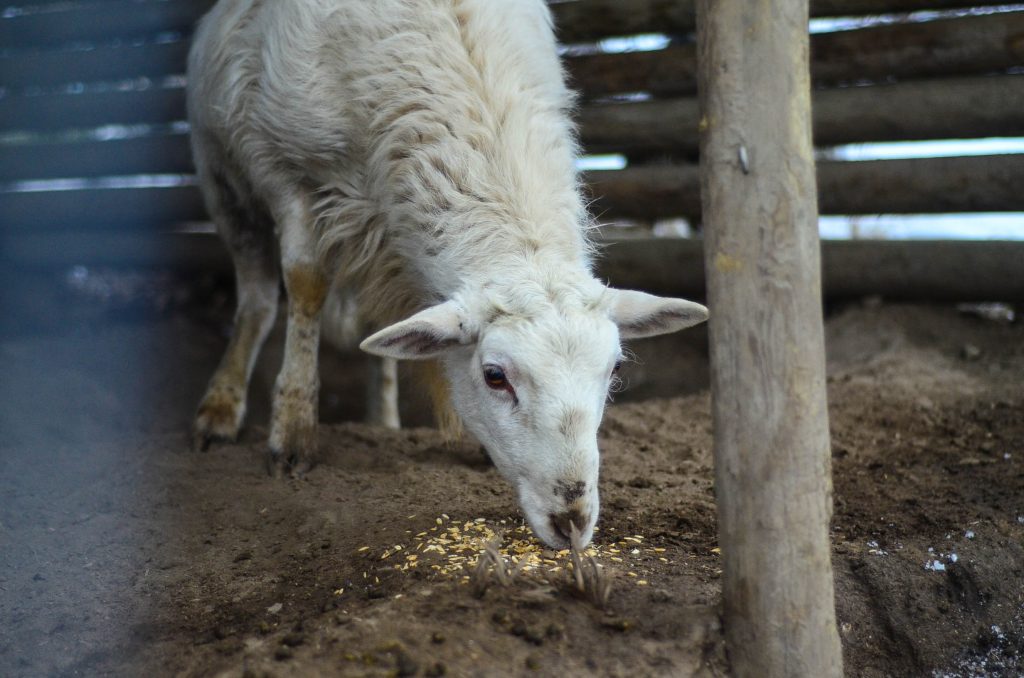
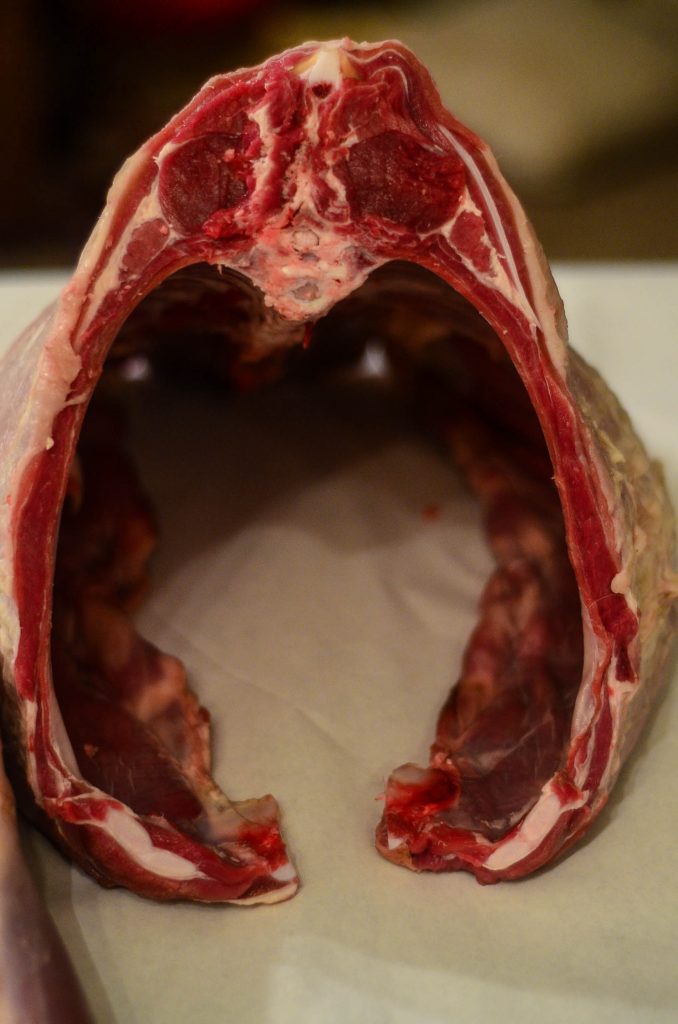
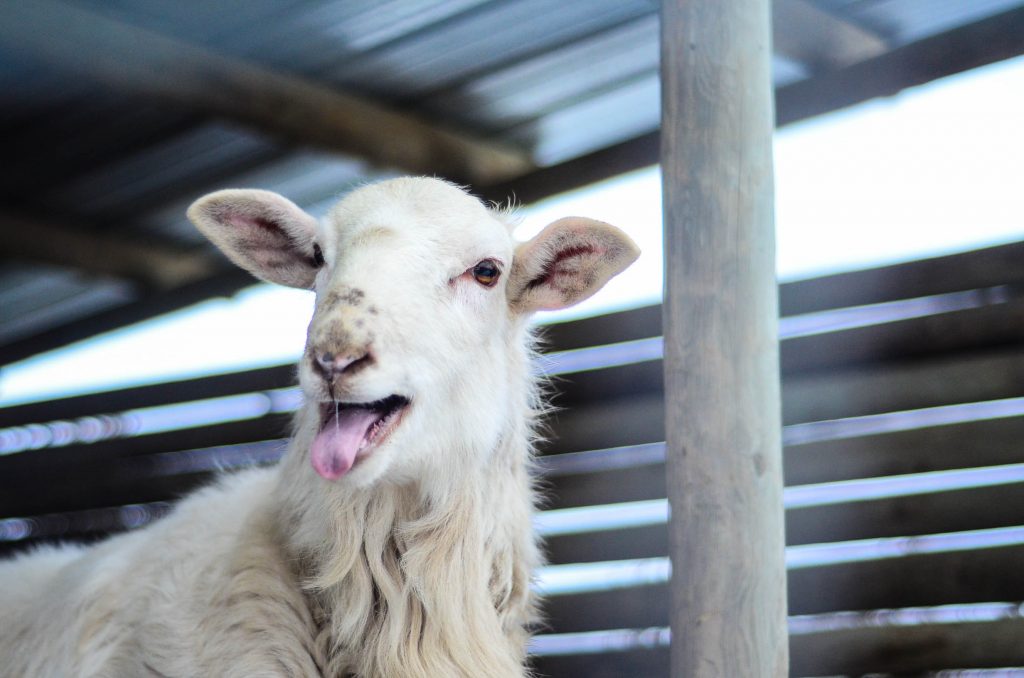
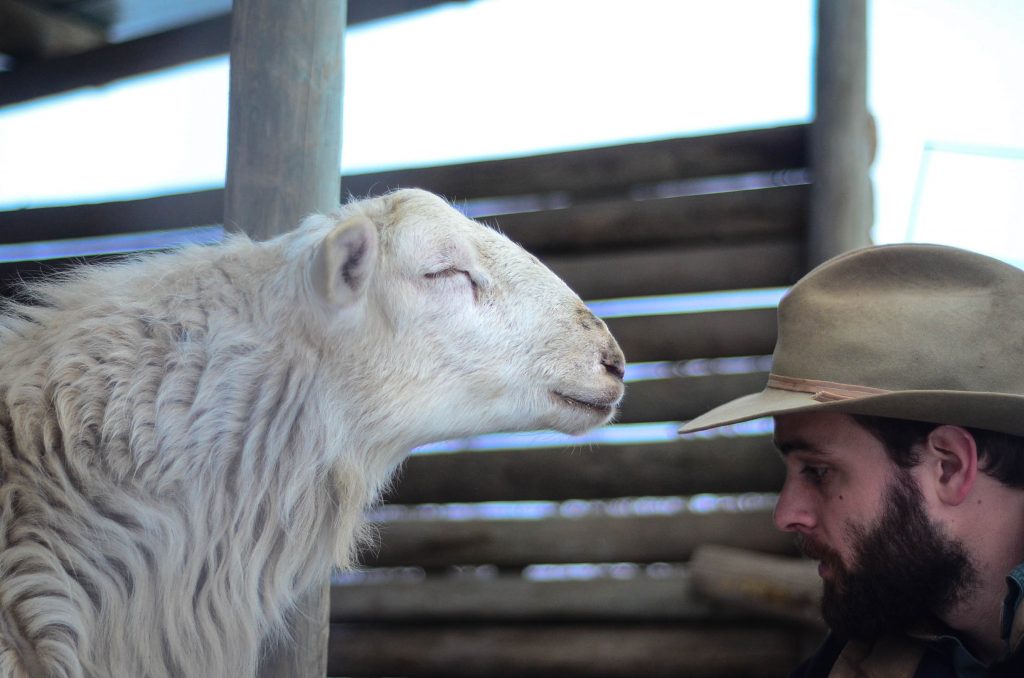

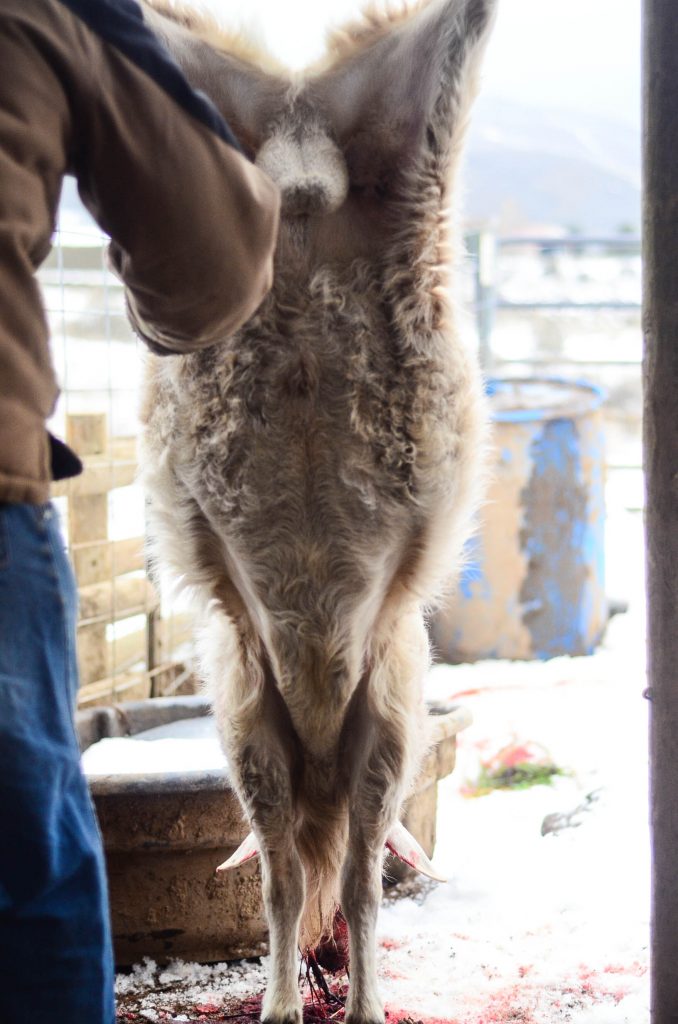
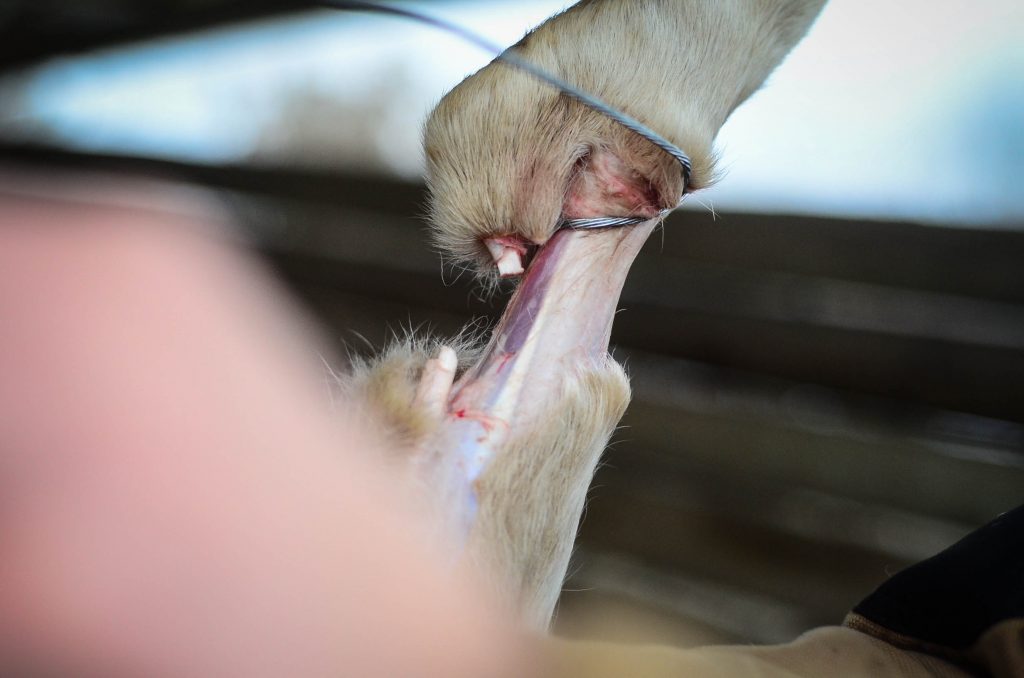
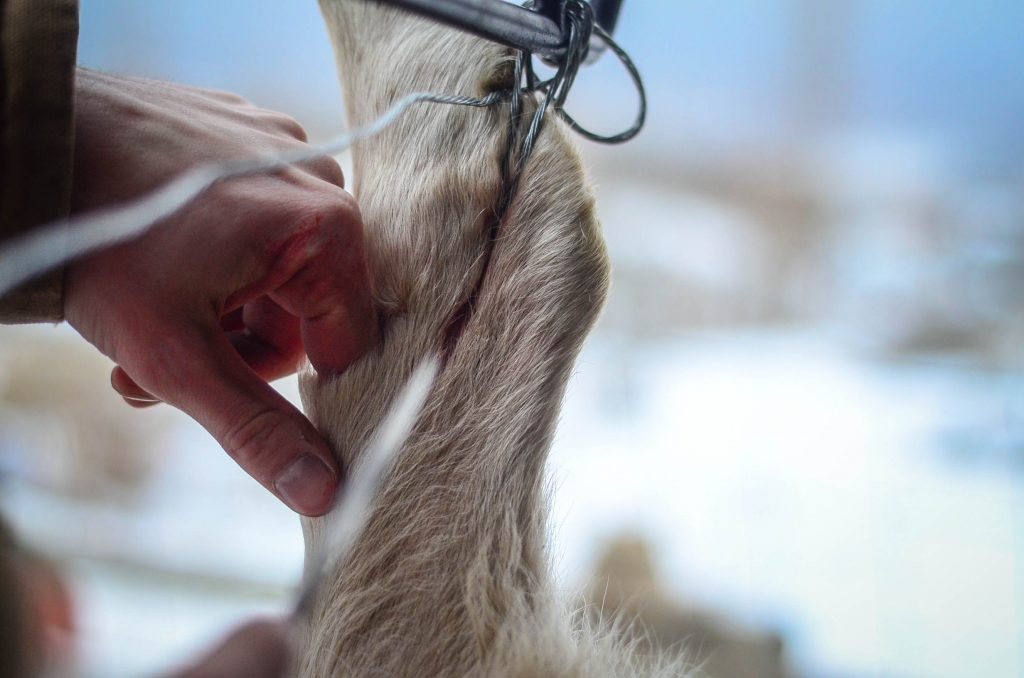
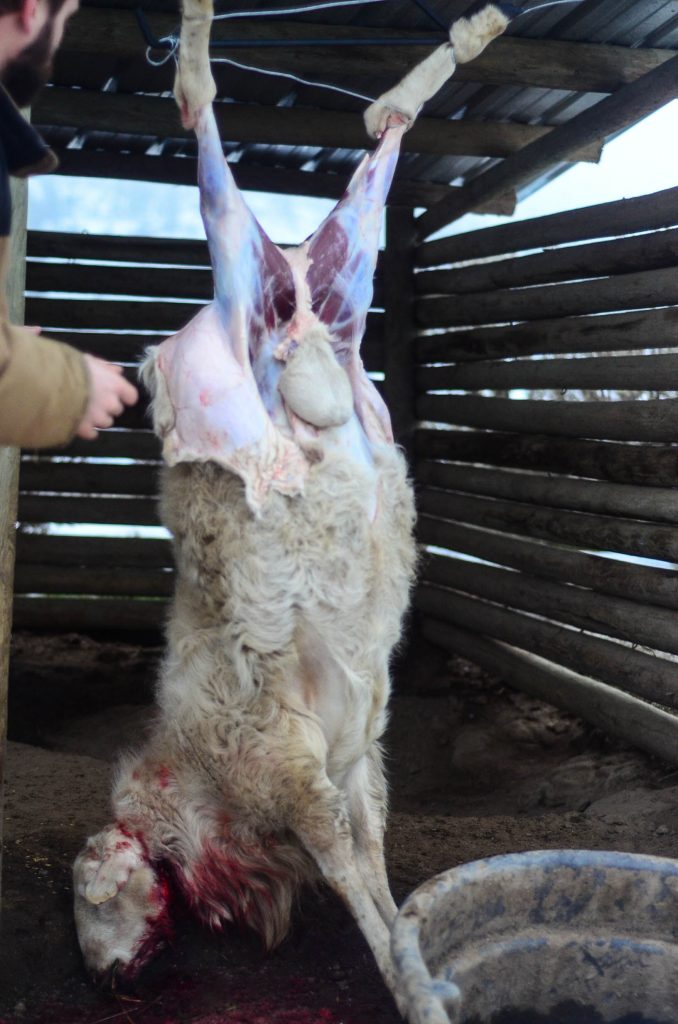
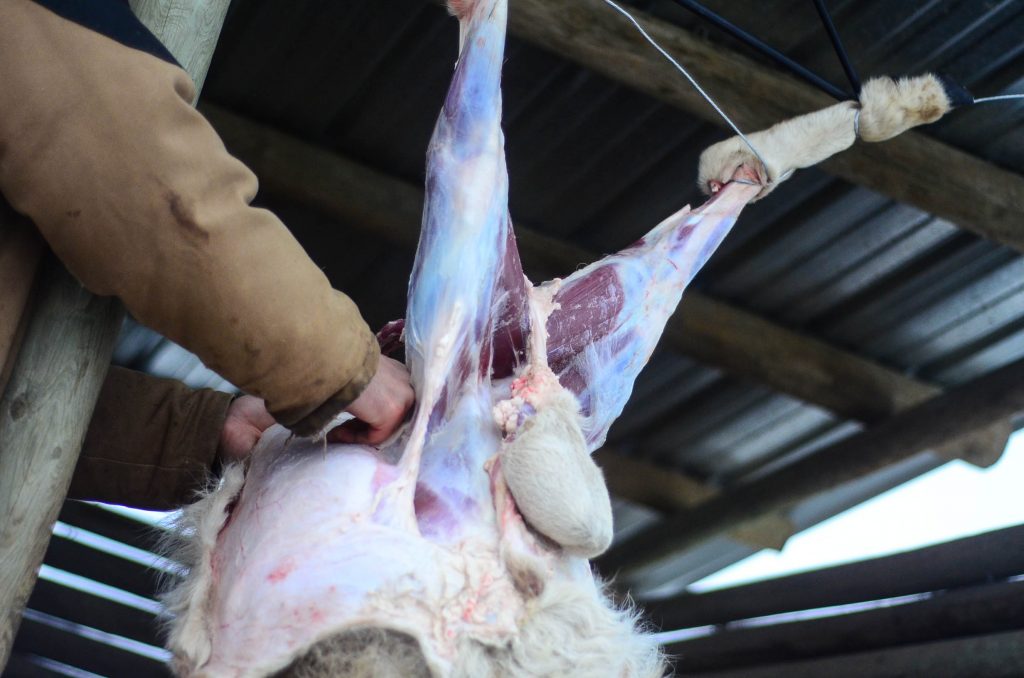
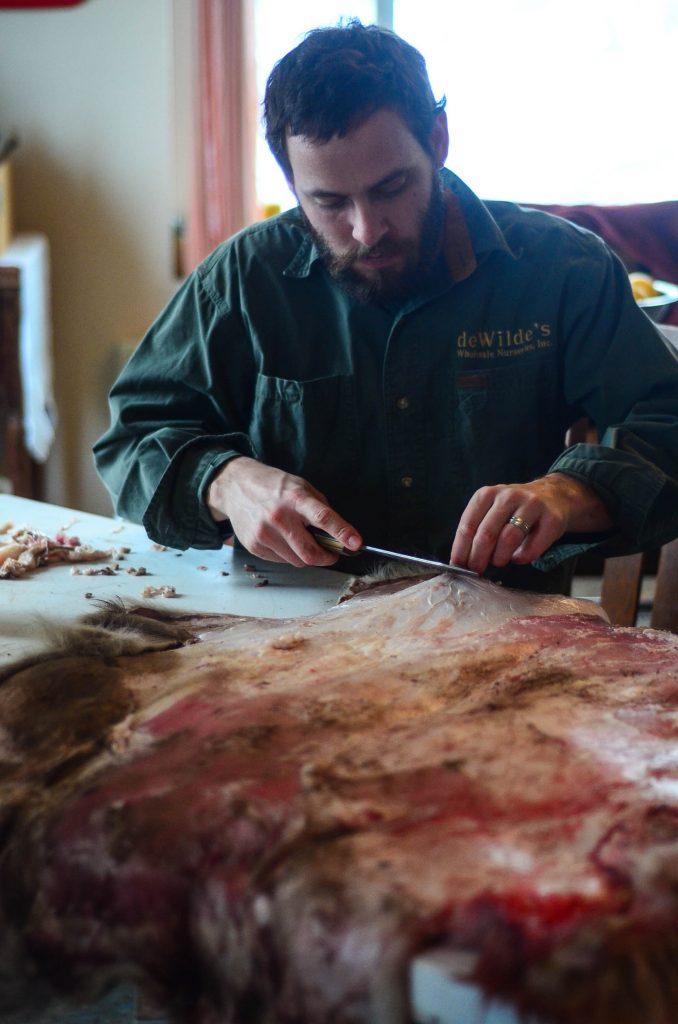

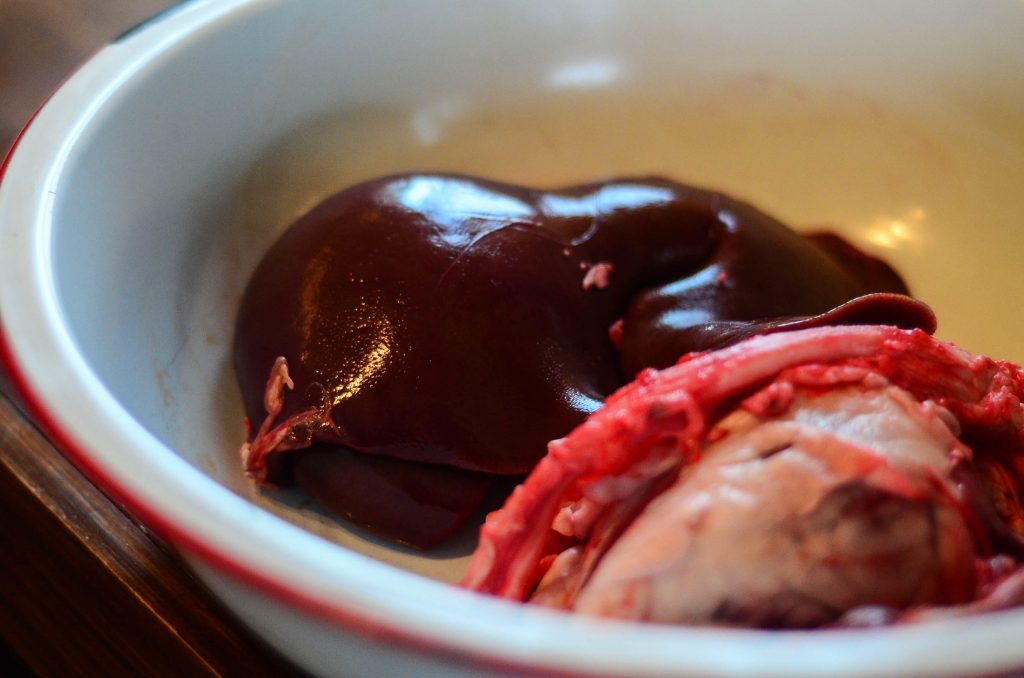
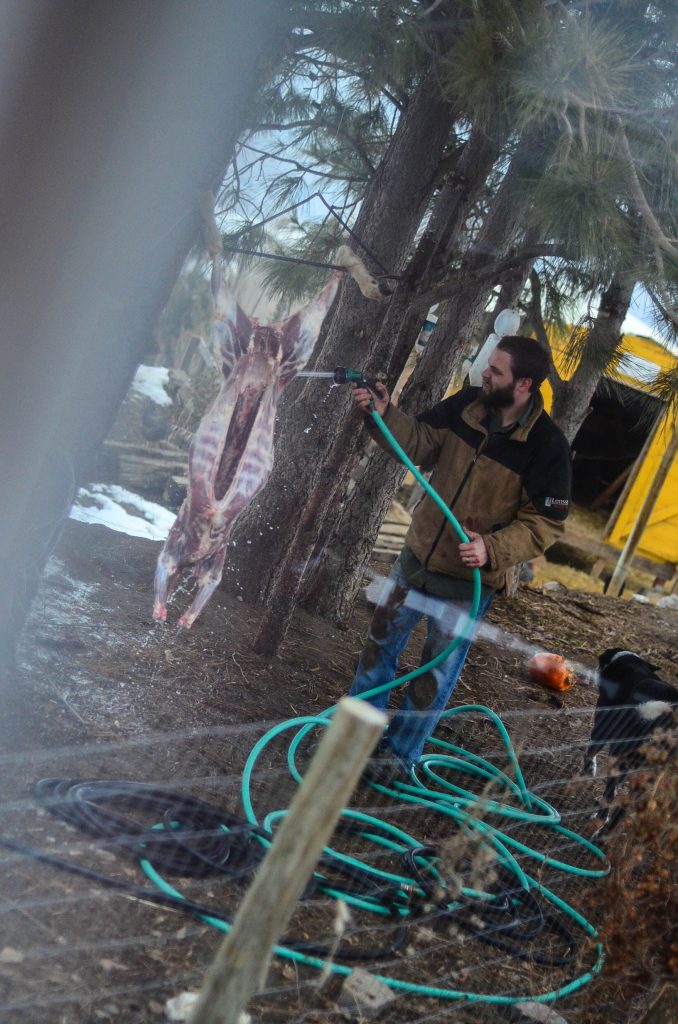
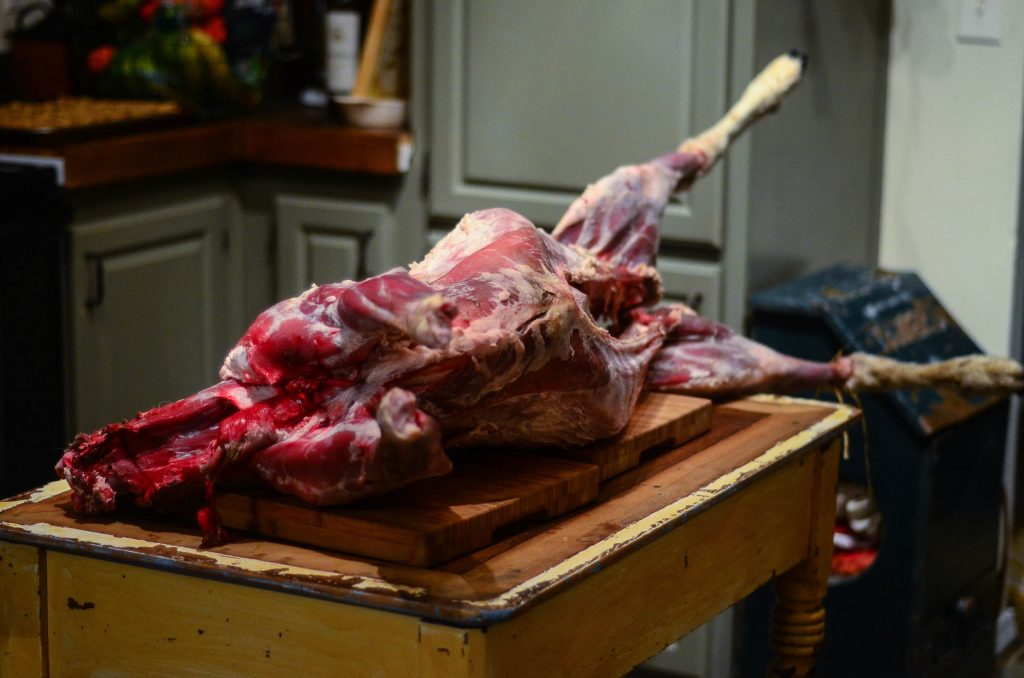
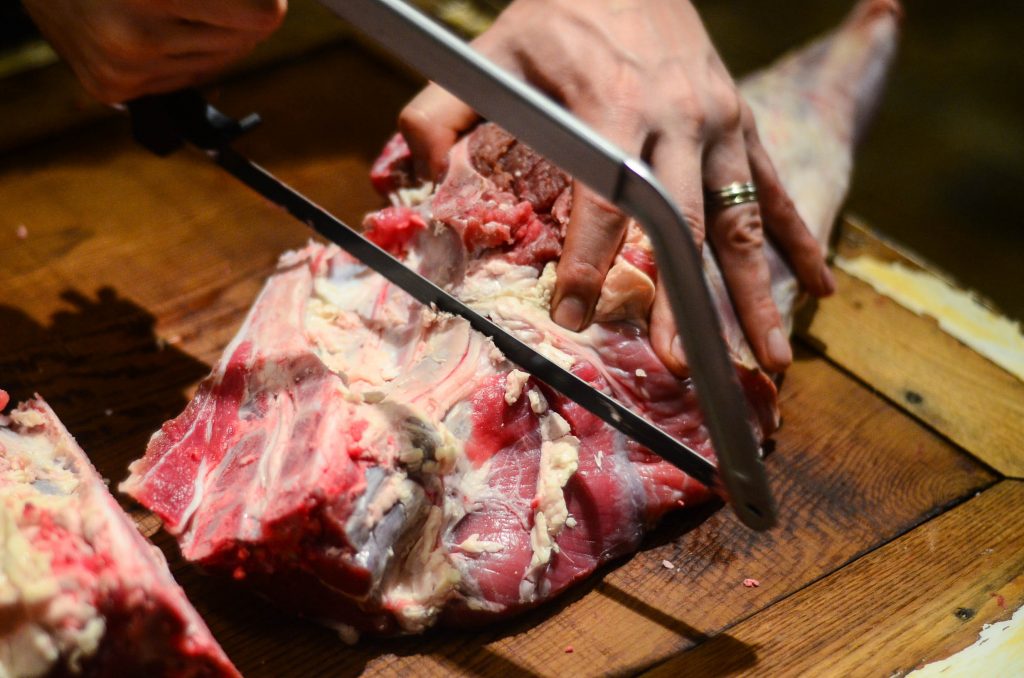
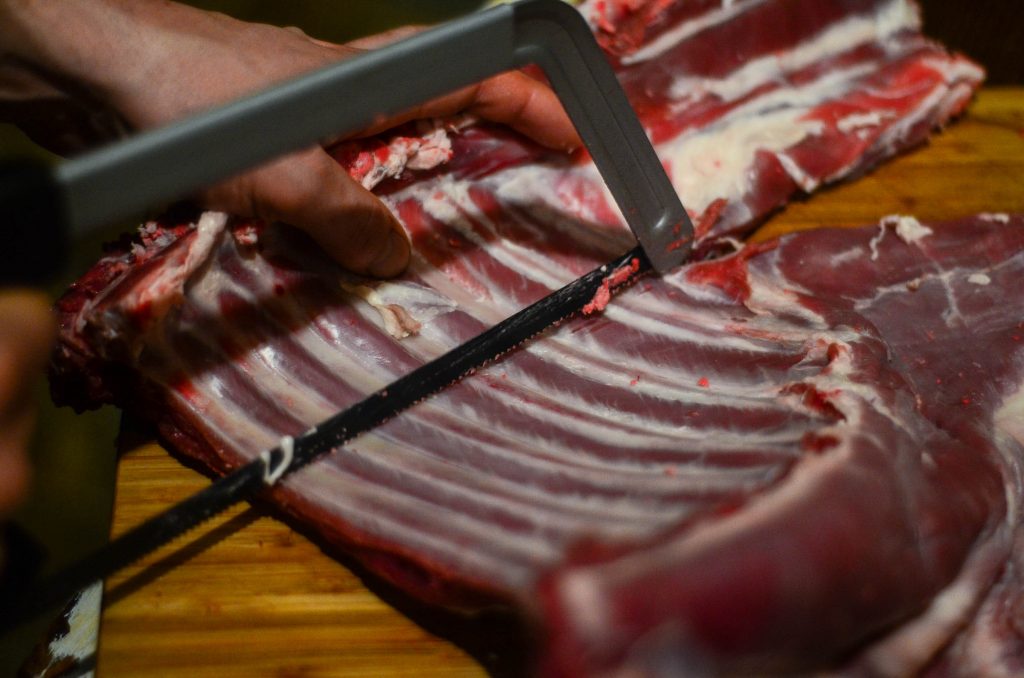
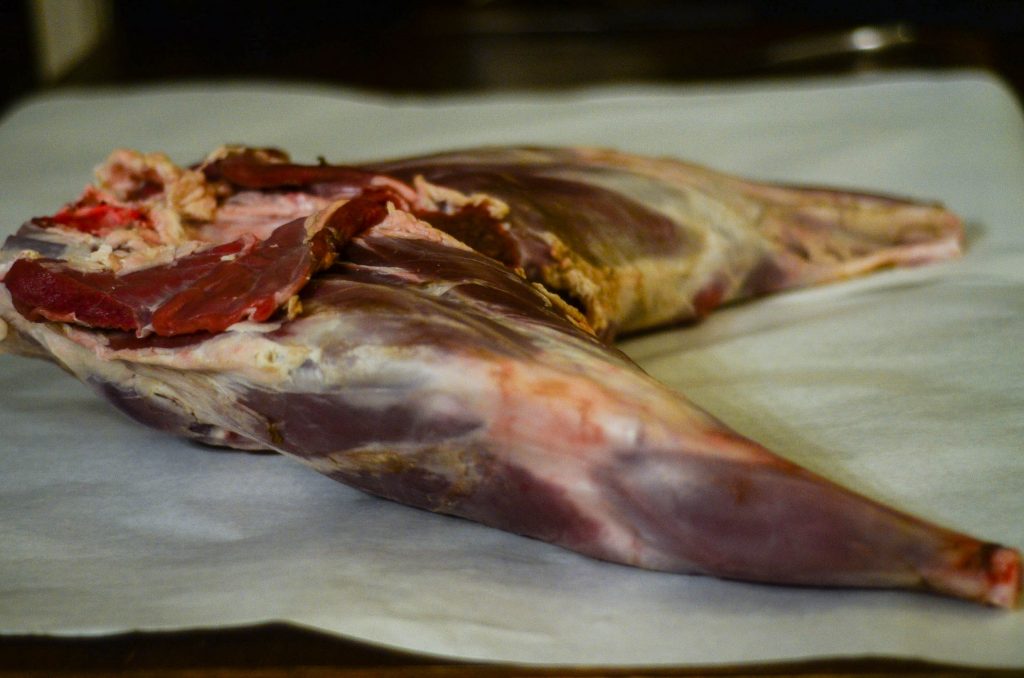
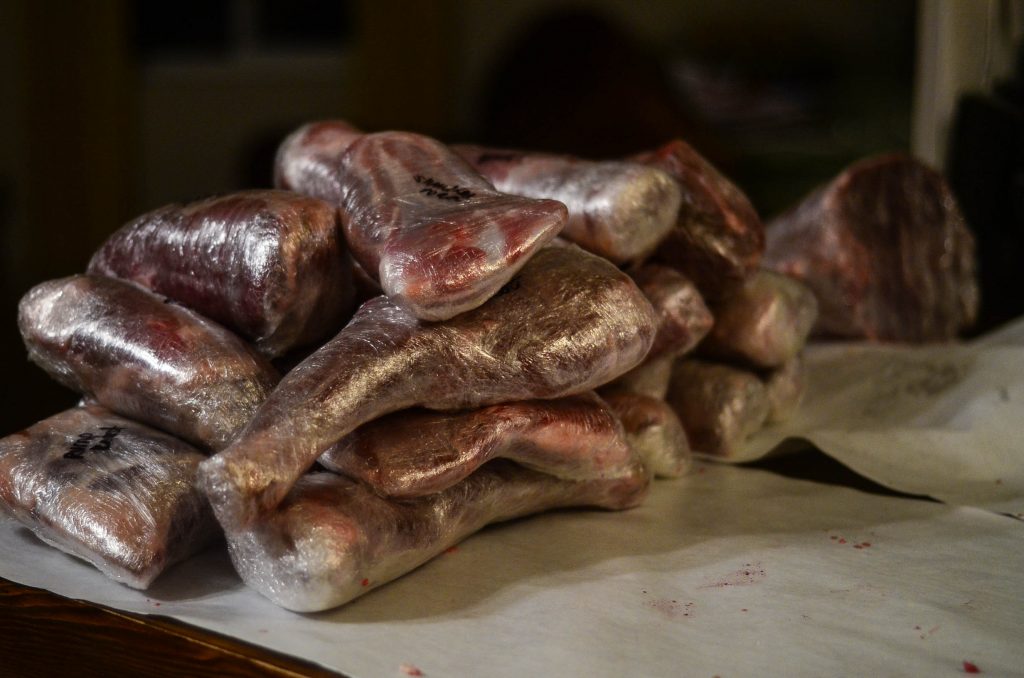
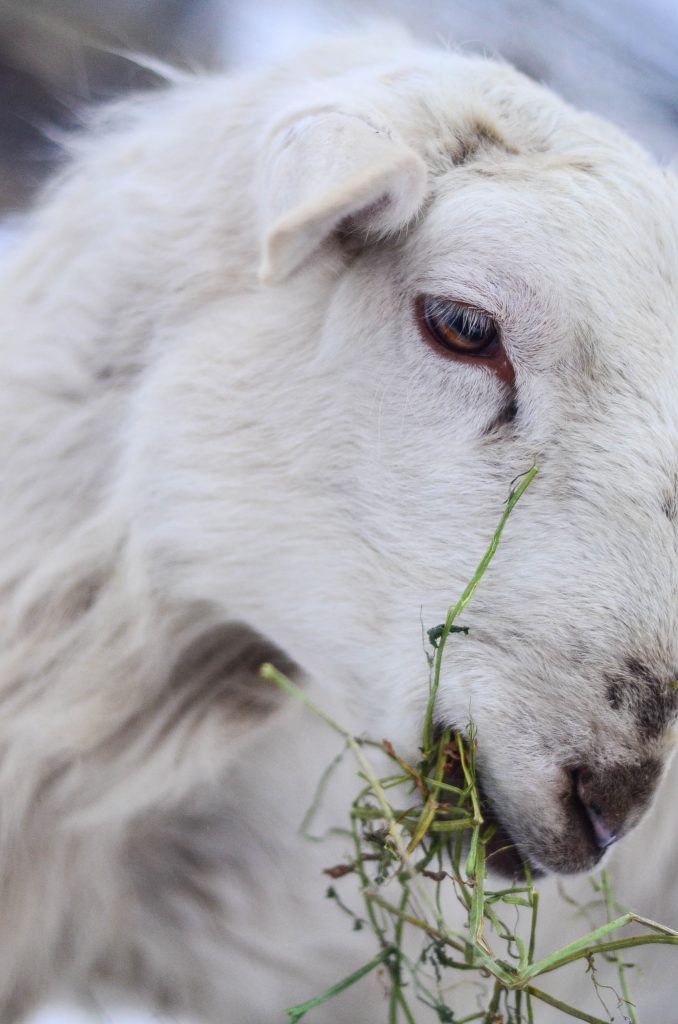
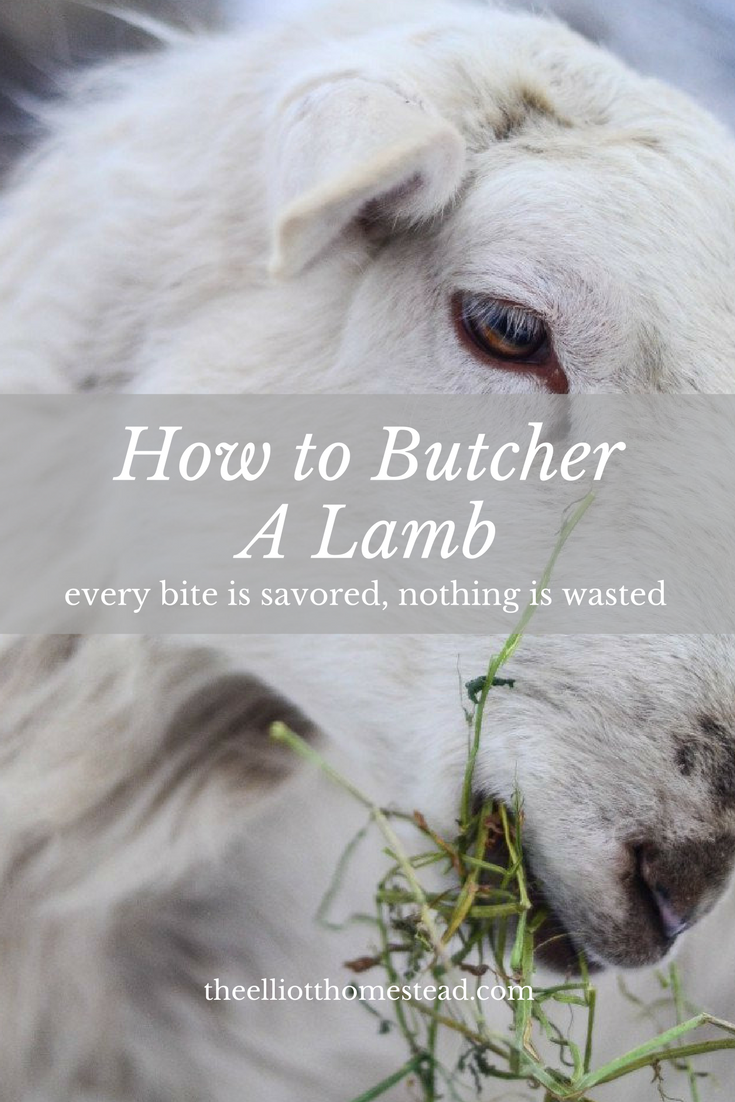
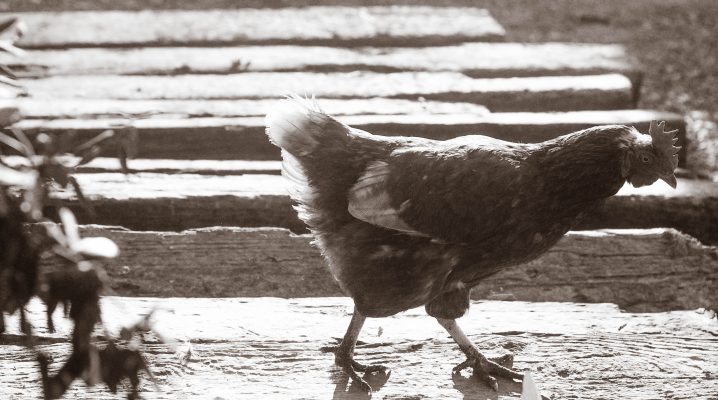
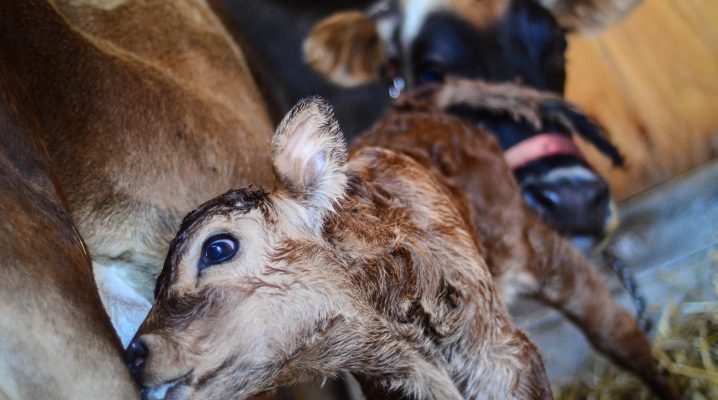
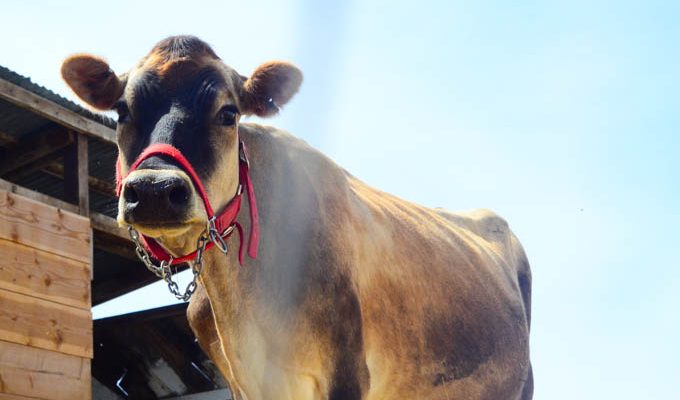
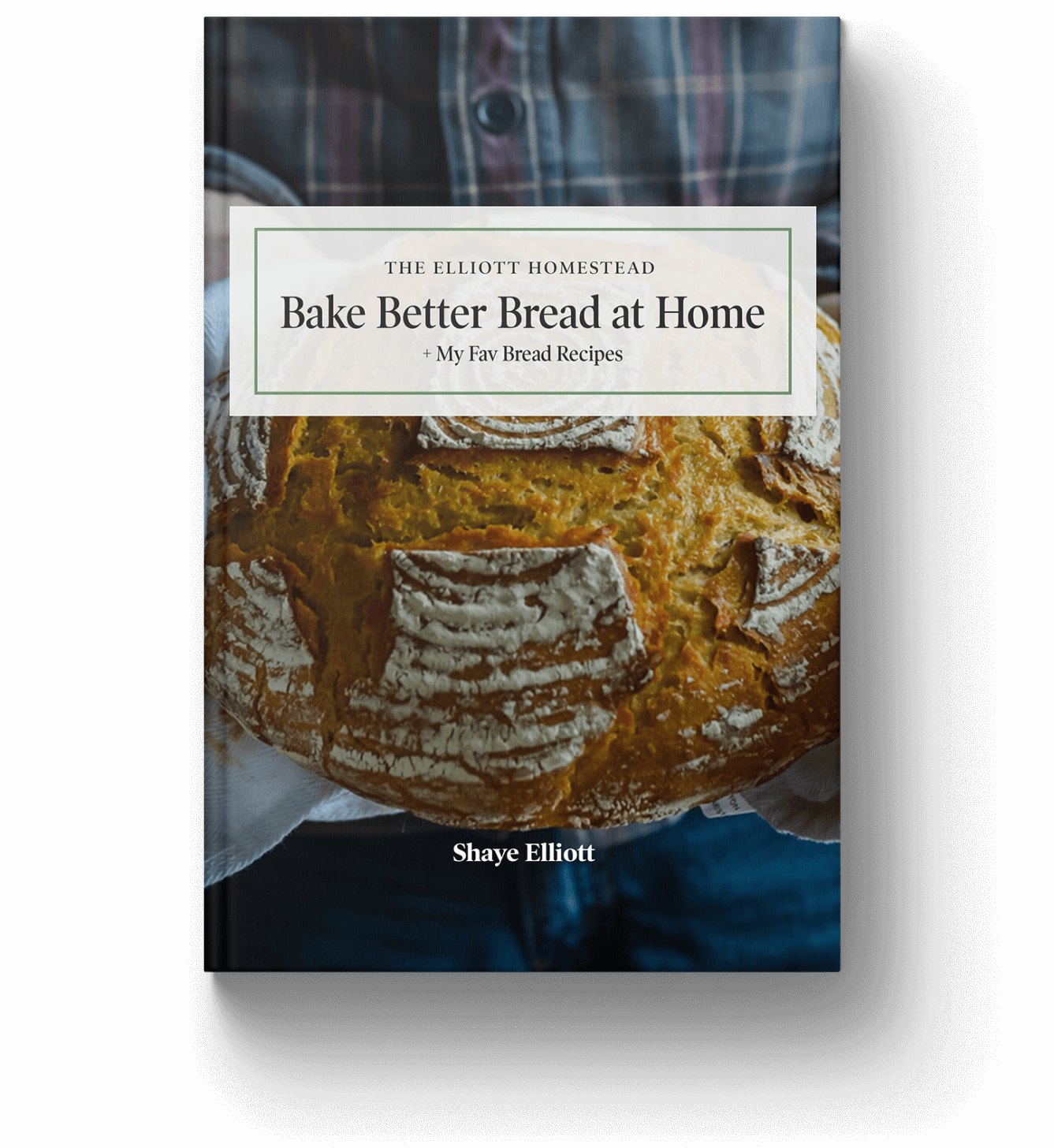
Thank you for sharing. I’ve been trying to convince my husband that raising a lamb for meat would be great. We butcher deer, but hubby is having a hard time separating farm animal from pet.
It’s hard to do. It helps to remember that it’s okay to love a farm animal as you would a pet, and it’s best that way even. I saw another article today written by Katherine Dunn on Modern Farmer (“Farm Confessional: What Butchering Your Animals Really Feels Like” found here: https://modernfarmer.com/2014/10/butchering-animals/ ). In it, the author says she prefers to hang white flags in their pen and pray for them and appreciate them and their sacrifice before slaughter. She prefers to be there in the same place when they are slaughtered. It makes it more personal, and makes it easier to bridge that gap between pet and farm animal. It’s healthier and more humane for all involved.
If that helps to read through for ways to handle the emotions going through his head.
What is your insight on how to buncher an entire lamb ?
I LOVE my pets. I could no more kill one of mine ( much less EAT one of them!) than I could SLAUGHTER then ravage their lifeless body! A body, that a minute before was full of life & love!! You disgust me with what you all do! And your lil “spiritual ritual” & your white flag crap fools no one. It is your mind trick at trying to calm the guilt of your soul!! I pray no more “pets” trust you!
You’re right! Instead we should eat animals who live horribly sad lives knowing nothing but abuse and neglect and suffer horrifically while they await their death! Your pseudo-righteousness fools no one.
Hahahahahaha! That was just what I was looking for! What is funnier is you had to be looking for this topic to see the article. I thought it was really good. I just finished slaughtering my pet boar and he will feed my family well into the winter! I always pray before I slaughter and after.
Your the one that is wrong. Life is a cycle. Animals eat other animals. We are in fact an animal in the life cycle. At least she raises it with care and it does not feel pain. An animal killed by another animal does not recieve the same end. Shame on you!!!!
It would have been okay for you to simply choose another website to look at. Yup you should have done that.
It is ok to be vegetarian. It is not ok to Judge others for what they eat.
No one is judging, we are only educating. It would be lovely if you would use these recipes in a vegetarian dish. I could not eat my pets and what is going in the slaughters houses is horrific (it’s comparable to a bloody horror movie)! Guido loved you (he melted my heart)! Maybe, we could compromise. Back in the day, meat was only served for special occasions. This could be a compromise. In addition, animal meat is full of parasites. Lamb especially…Lamb is considered to pose the highest risk for contamination across meats. Toxoplasmosis may follow consumption of meat containing Toxoplasma gondii cysts. Furthermore, there is an uptake in Creutzfeldt-Jakob disease (Mad Cow). When eating chicken, you are also subjecting your health to Campylobacter, Salmonella, or Clostridium perfringens germs. Try Vegan, for a while, you might like it 😊Could you please support animal rights. Thank you so much!
I’m sorry, but you have it wrong. By all means, enjoy your pets, but don’t poop on other people for pursuing their endeavors. You do you, and let other people do their own thing.
Humans are carnivores and mammals guess is so are you. Your disdain is therefore hugely misplaced and I have to wonder why you would even be in this website…Many cultures have lamb at the center of their cuisine, and perhaps you have read about Passover in the Bible and the use of lambs blood over doorways to protect their firstborns males when the Jews were slaves. You have no right to pass judgement on others for doing exactly what humans have been doing for centuries before you came along. Stick to your store bought meet from animals that suffer and are slaughtered, butchered packaged and sold so you can pickup packaged meat at the local store to fool YOURSELF that you had nothing to do with it. Think about that the next time you pull into Macdonalds or wherever and order your “happy meal”. I am a Misanthrope from a life of rubric spewing from special entitled fools like you.
Thanks for this guide. I had 2 lambs reserved for a guy to process on our farm but he might back out once he found out we are located 2 hours away. If I’m not able to find a butcher date close I might just have to dive in and give it a try when our lambs hit 50lbs. The step about towing the anus I wasn’t sure how you got to that step. I don’t want to mess up.
I always treat my farm animals with the greatest care and respect and when the day comes its always hard to say goodbye….
We are butchering our first lamb today. We started with poultry. Second year with pigs And now lamb chop. I fully believe that giving them love and a good life if important. I know the meat taste way better. After we put lambchop in the freezer we will have harvested around 400 ilb of meat. My hard diligent work for 8 months will feed us over a year
There’s nothing more tasty than a lamb burger cooked to medium and dressed like a regular beef burger. Also, roasted leg of lamb, stuffed with garlic and prepped with salt, pepper, garlic powder and onion powder, then roasted low and slow until medium is breathtakingly delicious! Having lamps and sheep is worth keeping. I promise!
I love your approach on these posts, Shaye. It’s thoughtful, and yet you don’t shy away from the graphic nature of processing animals.
Thanks, Jenny. We try and make it reflective of the experience.
this is a really good website thanks all of you and the compliments are mint
Thanks for the informative website. I was given a ram bc he fights all the other workers and barn animals. I liked him but i can’t help but make livestock into food when it’s time. I look forward to trying this new food. And yes i give thanks to God.
My mouth is watering just thinking about that amazing looking lamb! We got some grass fed lamb from the farm we have a cow share with, and IT. IS. INCREDIBLE! I know just what you mean when you talk about the satisfaction of raising your own meat. You know exactly what kind of food they were fed, and just how happy they were while you were caring for them. It is the best. 🙂 Love your pictures too!
so is mine pics so so good 100% perfect with extra thicc bits
Great post, kinda looks like a deer when all ready to hang. I have a question, does the breed you are raising taste different than other breeds of lamb? I heard lambs raised for wool sometimes don’t taste as good? Is this true? What is your take on this?
I would love to came over for some lamb, and I would do the dishes
Beautifully written. It’s amazing how much reverence we have for these animals that provide so much. I’m always heartened to read descriptions like yours that help solidify how challenging (but so worthwhile) it is to take this task head on and not turn away from an essential element of keeping livestock. Thank you.
I’m very intimidated by home butchering! It is one of my New Year’s resolutions to learn how/get familiar with the process. I saw that you watched a video and took a class but does everyone do this?! Everyone makes it look so easy!
I was raised and brought up in a farm with animals. Learned how to do it ,and ,I became a butcher of a meat packers that used to slot 6,000 hogs a day. Once you learn, yes it is easy, however , much better when your meat can be organic.
Will you be doing the tanning yourself? What are your plans for it once done? We will be butchering a goat and my husband was wanting to try his hand at tanning. Not sure what we would do with it once he is done.
Shaye-
We raise Navajo churro sheep for meat and fiber. Ours are also 100% grass fed. We love the meat as well, especially if it is marinated in buttermilk for 3-4 days – the flavor is amazing and the meat is super tender…
Great idea, Amy! Thank you!
As a girl who is just beginning her adventure in raising her own meat (rabbits), this post spoke to me. Really enjoyed this, as I do all of your posts 🙂
Thank you for sharing – we just butchered our first rabbits but we did not have a good knife. What kind of knife would you recommend?
I am from NZ and we have grass fed lamb here regularly. It is absolutely delicious. It’s one thing I couldn’t get over when visiting the States was that no one seemed to eat sheep. Beef, pork, chicken there was in plenty… but no sheep! Some friends of ours who shifted from England to the States actually ended up buying a block of land to run sheep on, just so they could have mutton and lamb. To anyone who has never tried it, I say go and try it ASAP!
I got a cookbook written by an Australian, and I couldn’t source a quarter of the meat and fish varieties without paying exorbitant prices through the internet, let alone finding it locally. The American diet is, how can I describe it? “Americanized”.
You can buy lamb in the stores though. I’m having a couple chops now.
I normally shy away from your butchering posts, due to the fact that they gross me out. Just keepin’ it real 🙂 I’m a wanna-be homesteader, and I LOVE a good lamb chop, so I decided to read through, and I have to say that this was fascinating and impressive (among still grossing me out). Reading about butchering, say, in Ingalls’ Little House books are different from reading blog posts on it, and reading blog posts are different from actually doing it. So here’s hoping I can align my perspective to yours and so many other conscientious meat farmers out there when, Lord willing, we will have a homestead of our own 🙂
And lamb always reminds me of this scene from My Big Fat Greek Wedding:
“Ian’s a vegetarian. He doesn’t eat meat.”
“He don’t eat no meat?! Oh…that’s ok, I make lamb!”
Thank you. That was beautiful as well as thoughtful. Having spent my childhood summers on a farm I realise it’s good to care for the animals but to always keep in mind they have a purpose.
A beautifully written piece. Handling a topic that may not be easy for a lot of people to understand unless you have made the decision to raise your own animals for meat, can be hard. The issue of raising your own meat is still a very tender issue, I for one am in favour of it and also have butchered my own and had someone come and do the bigger animals.
I am one of those people who believe that if we choose to eat meat, we should be responsible for how it is raised, slaughtered, and used. I especially like how you honored the animals and gave thanks for it. It is something I always do along with the tears.
Lamb here in Australia, is big business. There is a saying here that Australia rode on the sheep’s back, back through out history. Spring Lamb is always a must, roasted and or bbq’ed lamb has a big part in our food culture.
Good luck with it all
I’m an Aussie and we eat lamb maybe 3 or 4 nights a week. I love it, roasted, grilled, stewed, in a curry. So versatile. When I was younger we had sheep for wool and meat. Fat lambs here are usually a merino, border leicester cross. So the ewes are merino for the wool and the ram is a border leicester. Poll dorsets are also extremely good meat and the crossbred ( anything other than merino) wool is usually the wool used in carpets. I reckon if your going to have sheep, you may as well get money for the fleexe and meat!!! One thing I would have to tell you is that your meat would be doubly good if you had castrated that lamb. Wethers make well flavoured, tender and more fat marbled meat. Ram meat and bull meat are the toughest of the lot!
I loved your article , I butcher a lot of deer, hogs and rabbit. But today was rabbit butchering day and I became an emotional wreck!!!! I have been living off the land and raising my own food for years. After reading your blog I was like okay I can do this!! Fresh raised meat is so wonderful . I really enjoy your blog!!! God bless!
Great article. Lamb is my all time favorite meat…I wish I could grow my own..still looking for a good (not arm and leg costing) on line source of lamb!
Shaye – it looked like Guido was an intact male – was there a reason you kept him intact? My husband is a cattle rancher and has always said that the testosterone in intact males makes the meat taste funny, I was just wondering if this is the case for lambs or no?
Guido was intact- but he was so young, the meat had no flavor from the testosterone. Had we wanted to raise him for longer, he would have needed to be castrated.
Oh good that answers my question..less than a year old? I’m from central Washington as well
As an Aussie all I can say is that lamb is great. Lamb roast, lamb chops, lamb neck in stews, slow cooked lamb shanks yum. Don’t forget that home made mint sauce is a great accompaniment to roast lamb. We use a different breed here which seems to have more external fat which I quiet enjoy. Would butchering a goat be essentially the same?
Yes!
Sooo…I need a good recipe for the Lamb Fries! ;D
We have just started raising a few sheep ourselves. We currently raise chickens, duck, and turkey for meat and plan to add rabbits this year. Hopefully by this time next year we will have our first lamb on the table. One things I heard works really well during the skinning of sheep – make a slit on the leg (like you already do) and use the air compressor to shoot air under the hide. Apparently the hide will easily separate from the muscle. It is something we plan on trying when the time comes. Look forward to following your blog.
this post made me cry. I personally could not have a farm, i would have a million pets and become vegan lol…. i know i know it’s a way of life and they are meant to be eaten but not for me.
My grandpa used to raise sheep, and many of my uncles still do. Grandpa did his own butchering (lamb, pig, chickens, beef) and taught me to cook roasts when I stayed with him.Before I was married I was able to get as much as I wanted free. Of course grandpa also gave me 2 milk cows for have the price as one when I decided at age 6 that I wanted a milk cow like my mom. Sorry sidetracking, your blog reminds me of my grandparents.
I have tried cooking lamb so many ways and my Husband finally asked me to stop around our 3rd anniversary , he just didn’t like it.
This makes me want to sweet talk some relatives and have some on hand for when he is gone for Guard weekends and see if I can’t improve my skills. Making soaking it in buttermilk would help like when cooking elk?
It’s weird how Americans don’t seem to do lamb very much, in Australia it’s a staple, more so than beef or pork. I know you have hair sheep but do consider getting a couple of woollies one year, shearing is not so difficult (it’s definitely full of laughs the first try though!) and it’s super awesome to have a big doona (quilt) stuffed with your own homegrown wool! Nothing more comfortable. It’s warm and snuggly, but it breathes so you don’t overheat. You can even get the kids to sew their own patches on the cotton cover!
Read your blog on acquiring lamb and the latest on butchering. Very informative and well written. I’m on the east coast in NC. I have been searching locally and I’m finding lambs are about $175 and up! Can you comment on the current pricing? Your post had suggested $50 per lamb and im curious if the market value has trebled or if Katadin are just rare here in the east? Our plan is to buy a pair and begin a source of homegrown lamb. $350 plus fencing just to get started…. We have 8 acres and will section off a paddock and divide it in quarters to rotate grazing.
I like lamb sells for $5/lb (cut and wrapped) on average.
So how much did he dress out at?
This lamb dressed out at about 75 or 80 lbs.
Hey Shaye as always love the post. We slaughtered our first two lambs last weekend. The are North Country Cheviots. Letting them age now. Can’t wait to make some curry or Indian “65” (my favorite) with them. Have you ever tried making sausage? We are going to try this weekend – maybe adding some pork as well and try kielbasa. Keep up the posts love reading what is happening on the farm!
Great guide on how to butcher a lamb. Really goes through all the steps in detail and the method and respect given to the animal is honorable.
I found this article very informal/helpful. As someone who regularly harvests and butchers my own deer every year, I found quite a few similarities to my own experience with venison. One thing I’m curious about though, is why do you rinse the carcass with water prior to letting it hang? I’ve always been under the impression that introducing water to the carcass promotes bacteria growth and therefore I never opt to rinse with water unless the deer was gutshot or there is a serious mishap during field dressing. We typically use a propane torch to remove excess hair; just don’t hit one spot for too long. My assumption is that with a controlled harvest/butchering process, most of the excessive blood and hair are much less likely to soil the carcass as compared to a wild game harvest/field dressing. I look forward to reading your reply. Thanks much!
I see he was intact. Do you think it makes a difference in flavor? Also, how about mutton? I’m butchering some rams right now and our family thinks it tastes very good.
Thank you for sharing your journey. We raise Shetland Sheep and will be butchering soon. The care and compassion you have for the animal and the process are commendable. Your gratitude to him for his sacrifice is touching and appreciated. Reading this has made the task we face seem much more approachable. We hunt and eat what we harvest, butchering our game ourselves but I was considering taking our lamb to a butcher because of the attachment we have to them. Thank you again for sharing and making the process a little less daunting.
Well i am going to harvest my first lamb tomorrow. I didn’t think about the ageing process. Too warm here in Tennessee, will have to refrigerate it. Learned other great tips also. My confidence is up….the kids need to stop naming them though. Hopefully I ll the trigger. Greg
Although I could not take this life, I thank you so much for honoring the life of your animals.. my Buddhist nature approves of your thoughts and consideration. /bows/
Jesus us the real truth
We have had sheep for milk and fiber for about 8 years now. Last Sunday we butcher our first, and today we butchered our second and third ram lambs. The killing was tough, and there were a few tears. Then I wasn’t sure if we would be able to eat it but we have had lamb for dinner 3 times already!
Thank you for your post, and I wish I would have found it 2 weeks earlier.
Any suggestions for a fast kill that doesn’t involve shooting? I’ve come to love lamb brain and want to both have a humane fast kill as well as the ability to harvest the brain.
Dave, years ago I researched this subject. I came across a research article from Germany that studied conventual stunning verses halal slaughter. The researchers hooked up brain monitors to the lamb. Short story is the lamb that where stunned before slaughter had brain reaction to being slaughtered yet the lamb that was slaughtered using halal technique lost all brain activity 3 seconds after being cut. Halal slaughter is saying a short prayer for the animal and then cutting the two main veins in the thought without cutting the wind pipe. The brain is under pressure and once the main veins are severed the brain looses blood and becomes dormant with the last signal is to the heart to send it blood. This reaction causes the body to pull blood from the tissue and pump it to the brain, in essence clearing out all blood which also carries stuff that needs to be removed making the meat cleaner.
Halal an kosher slaughter are the same just different religion. Religion aside the methods are intended to minimize animal stress. I have found that having a practice run with good restraints helps ease the animals fear of the process. Take them through the steps once or twice but give them a treat after. On the day of slaughter they will be more at ease and so will you. Also use a good quality and very sharp knife as a sharp knife can cut with less pain.
Yes once you have had brain it’s hard to let that go to waste.
Just got to have an open mind 🙂
My brother who has a farm is bring me frozen lamb. I never watched the buthchering. He has farm worker help who I don’t trust, Is there any way in 104’F this month that the lamb might carry bacteria or other after butchering human illness from leaving the carcass in the heat too long before cooling the meat?
Great post , we also brine and smoke the rear legs as in the norweigan tradition .this year we will also make gyro meat with our lamb and grass fed beef .
Hi Nick and Shaye,
I really appreciated your post on butchering a lamb. I am just starting out on a new adventure of raising lambs for meat and currently have two lambs that will be processed this October. I will not be butchering myself … this time … but after reading your post, I think I will be doing it myself after this. My grandfather raised meat sheep while I was growing up and I enjoyed helping him on the farm and often assisted with the butchering. I am going to try my hand at tanning the hides this year so, one thing at a time and I’ll have this figured out. I know it can be hard to butcher lambs you’ve cared for and have grown close to but I believe this is the purpose God put them on this earth for in the first place and for that I am grateful.
Thanks again for not only being straight-forward with the details of your post but for the way in which you included God and thankfulness in the process.
OOPS! Sorry Shaye,
I read the posts so quickly I addressed my post to NICK and Shaye… should’ve been Stuart and Shaye. My apologies.
I totally agree. What you are doing to the animals is a total fraud (first giving them love and care and the shoot them in the head…).
Don’t use God & Amen as a warranting for killing animals you claim to love and care for… Just be honest and say you like the meat and do not try to justify your actions by God & Amen.
I am pretty sure that a loving God is pretty much against any form of killing and emotional fraud the way you practice it with your animals.
This is betrayal at its best!
No he isn’t against it. Read your Bible. He gave people animals for food after the flood. They are doing it correctly instead of factory farming which is often abusive.
I always dropped my sheep off at the butcher processor. That was a sad and well, horrible experience. I’ve now moved and had to give up my flock, but this weekend I will be slaughtering 3 per sheep from a friend. Any advice on how a complete stranger (to the animals) can keep them calm before doing the deed?
This was nicely written and I appreciate your response to the pet lover. Too many people have the “Old McDonald” view of farming and forget where food comes from… especially food grown in a CAFO, gross!
Respect the animals. They should live a wonderful life all the way to the end!
This was a beautiful read. Thank you for sharing your knowledge and for giving an in depth step by step process for the slaughtering. It shows how much you truly care for and respect your animals.
I got two Dorper meat lambs in spring, and asked my grandkids to name them. “Ying and Yang” they said. I butchered them in winter and got two new ones in spring.
“ What happened to Ying and Yang” they said. “I processed them, do you want to name the new ones?”
They glared at me: “why dont you name them Tasty and Chewy” they said.
Great article. Really informative and well written. Thank you for the insight and information. We have two lamb’s who are nearly really to go to lamb heaven, mighty helpful, Thanks!!
I noticed your Ram was still intact? I’m a newbie, getting a 3 week old in a couple days. Trying to decide if I should castrate him?
Brother that was amazing story and lesson to learn.. Amen
Where your farm located.
Greetings from Northern California. We had an ewe, Violet, get her head caught in some netting the other day. By the time we found her she was pretty messed up. Not dead, but almost. She is showing little improvement so it looks like she is headed for the freezer, and eventually our table. I truly appreciate the tutorial. Easy to comprehend, thorough, and simple. THANK YOU.
PS…I thought the one comment was someone being funny…Horrified that you would consider eating your pet lamb. When I realized that she was dead serious…I was horrified. Horrified that we have people amongst us that actually think like that. People that VOTE. eek.
Hi, thank you for the great post. I do have a question. I see a lot of people skin their lamb first and then gut. We haven’t butchered any lambs yet but we’ve done our own beef and wild game for a long time and always gut first and then skin. Just curious if there is a specific reason for skinning first, or if it is just a preference? Thank you, I appreciate it.
I have 3 lambs 1 which has a bump front leg, it trys to keep up with the other 2 but seems to be getting worse so I plan on butchering her so that she does not go to waste, id rather not as they help keep my grass under control on my 3 acres but I think it is more humane to butcher & eat than let her suffer as I can’t afford a vet bill
I just found this page during preparations to slaughter our first ewe. We have a smallholding, our ewes live a wonderful life, free ranging, plenty of forage and treats. They are treated so kindly and well cared for. I wanted to ensure that the next step was done properly, without suffering, and showing absolute respect to every single inch of our ewes. The photos in this guide have been so useful. I stood there as our ewe quietly slipped away, no crying, no suffering. She had a good life and now she will nourish ours.
Quick question. We butchered in the summer so we did the cutting and are aging it in a spare fridge. How long do you think I should age it before wrapping and freezing? It was a yearling
When shooting the lamb, how did you set up the lamb and dispatch it so that the kill was quick and safe for you? I am afraid to shoot a lamb because I can’t tie them between crossties as one would while grooming a horse, for example. Do you just put grain down for him and quickly shoot him while his head is down? Is there a danger of a 38 or 9mm bullet ricocheting and hitting oneself?
Raising Dorpers for homestead meat in rural Missouri. Thank you.